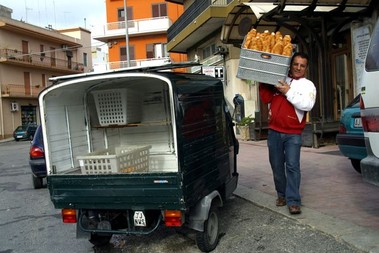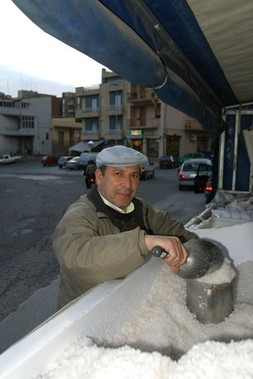It’s not delivery, it’s truck dining
February 21, 2007 - Associated Press - asap

ISPICA, Italy
The concept of “dining a la truck” in Sicily was introduced to me over a loudspeaker. I was still in bed.
Garbled voices came through the window. I’d only been on the island for about 10 hours and was sure it was local politicians canvassing for votes. Mercifully, they disappeared and I went back to sleep.
Later, I’d learn that a small armada of trucks makes the rounds in this small, sleepy city (pop. 14,000) and others like it, calling out their offerings, like just-picked veggies, fresh cheese, poultry and even cleaning supplies, and selling them at their customers’ front doors.
It’s a mix of tradition, impossibly fresh ingredients and brotherly love.
THE RIDEALONG
To see how it worked, I loaded into Angelo Denaro’s big, sky blue Fiat truck that his father bought 31 years ago and we drove off, very slowly, into the back streets of Ispica. We were selling salt.
He reached down onto the bench seat and, like two generations before him had done, grabbed a microphone.
 Sicilian mobile salt salesman Angelo Denaro fills out one last order at the end of his day. (Photo AFP/Joe Ray)
Sicilian mobile salt salesman Angelo Denaro fills out one last order at the end of his day. (Photo AFP/Joe Ray)“Sale, cu s’ha pigghiari ‘u sali!” (A Sicilian/Italian blend of “Salt! Who wants salt out there?”).
He scanned ahead and in the mirror. Nothing.
In the middle of an intersection, he stopped and tried again; it felt like fishing. We never got past second gear.
“Slow day,” he said, and despite the quiet start, he avoided the temptation to use his loudspeaker to sing Sinatra to the townspeople.
The first strike came after about 10 minutes—a little old lady (and they’re all little old ladies) in a shawl waved us down and walked out with an empty glass jug. Denaro flipped open a large fiberglass tub in the back of the truck, filled her container until it was heaping with more than ten ponds of very coarse salt, collected a whopping 1.30 euros (about $1.69), chatted for a bit, and drove on.
Another client bought more than 40 pounds of salt, which Denaro hefted all the way into her house. I asked him if it was for something special.
“Nope,” he said, “It’s just better than if you buy it one kilo at a time.”
 Fresh ricotta & friend.(Photo AFP/Joe Ray)
Fresh ricotta & friend.(Photo AFP/Joe Ray)It also turns out that large quantities of the coarse stuff are used in the plumbing systems here as a water softener.
In two hours trolling the narrow streets of Ispica, we passed more Fiat 500s, stray dogs and old ladies sewing in their front windows than I’ve ever seen.
TAILGATE FRESH
A few days prior, I took a break and scanned the rotary from the window. Below, a woman gave money to a man next to a small white car then walked away, gently cradling a wheel of fresh ricotta.
I ran.
Giuseppe Cappello is a third-generation cheesemaker and seller on wheels. He opened the back of his tiny white car, then scooped my ricotta wheel out of a large, white tub containing several other wheels floating in whey.
It was still warm.
I paid and ran again—this time toward the kitchen.
The ricotta had a custardy texture similar to the white of a soft-boiled egg; a snow-white miracle in a tiny, plastic colander. I cut some bread, added some still-warm ricotta, poured some local olive oil and a sprinkle of salt over it, took a bite and, well, groaned with pleasure.
“When people buy it, the cheese is between half an hour and an hour old,” said Cappello, who sells to an estimated 120 clients and one restaurant from his car. He and his wife Enza also sell to wholesale clients from their farm on the edge of town. “We’re proud to say that our ricotta is sold hot,” he said.
He also seemed unaware that he’s got most pizza chains’ claims to fame beat coming and going.
It dawned on me that with most of the food items he and the rest of the food cart crew offer, there’s no possible way to get fresher (and in many cases, better) food, unless you’re camped out at the farm.
MEALS ON WHEELS, INC.
Later, baker Filippo Di Loro and I piled into a green Vespa Ape—a three-wheeled scooter/truck hybrid—to go on a delivery run. My head touched the ceiling and my knee was wedged against the steering column. Di Loro had to reach over my legs to grab the handlebars.
A baker and deliverer for 18 years, Di Loro has run the town’s best bakery, Panifico del Popolo, for the past five years.
He asked if the Ape (“bee”) is popular in the United States and, imagining it in a collision with a SUV, I made the “squished grape” sign with my fingers. For rural Italy, this is progress; some here still remember when bread was delivered by bicycle.
“Delivering is a service to the client so they can get their food at home,” he said. “Normally, we probably shouldn’t do it, but how can you say no?”
It was easier to understand what he was talking about when he made his first delivery to a deliberately moving elderly woman who took her delivery in a housecoat. Di Loro estimated that the lion’s share of the individual deliveries he makes are to clients well into their golden years.
“If a client calls and asks if we can come with some bread,” he wondered aloud, “how can we say no?”
___
asap contributor Joe Ray is a freelance food and travel journalist based in Paris. He can be reached via his Web site, http://www.joe-ray.com.